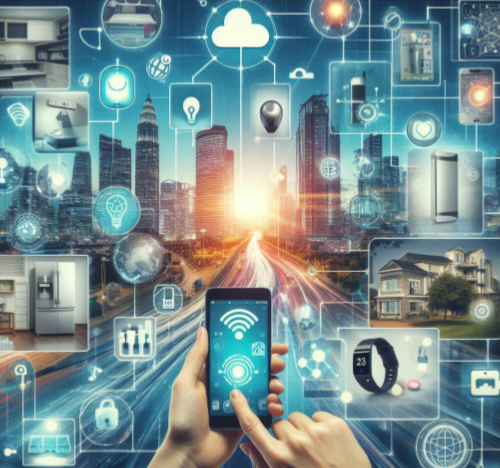The Internet of Things (IoT) is revolutionizing how devices, sensors, and systems communicate and interact, creating a network of interconnected devices that collect, exchange, and analyze data to drive insights and automation. From smart homes and cities to industrial applications and healthcare, IoT innovations are transforming every aspect of our lives. In this article, we’ll explore the latest advancements in IoT technology and their potential impact on various industries and sectors.

Understanding the Internet of Things (IoT)
Interconnected Devices and Sensors
The IoT refers to a network of physical devices, sensors, and objects embedded with internet connectivity and communication capabilities. These devices collect data from their surroundings, such as environmental conditions, user behavior, and machine performance, and transmit it to cloud-based platforms for analysis and processing.
Data Analytics and Automation
IoT data analytics and automation enable organizations to derive actionable insights from vast amounts of sensor data and automate decision-making processes in real-time. Machine learning algorithms and AI-driven analytics tools help identify patterns, anomalies, and trends in IoT data, enabling predictive maintenance, optimized resource allocation, and personalized user experiences.
Applications Across Industries
Smart Homes and Cities
IoT technologies are transforming homes and cities into smart, interconnected environments, where devices and systems communicate and collaborate to enhance efficiency, convenience, and sustainability. Smart home devices, such as thermostats, lighting systems, and security cameras, enable remote monitoring and control of home environments, while smart city initiatives leverage IoT sensors and data analytics to improve urban infrastructure, transportation, and public services.
Industrial IoT (IIoT)
In the industrial sector, the Industrial Internet of Things (IIoT) is revolutionizing manufacturing, logistics, and supply chain operations by enabling real-time monitoring, predictive maintenance, and process optimization. IIoT sensors and connected devices collect data from industrial equipment and machinery, allowing organizations to identify inefficiencies, reduce downtime, and enhance productivity.
Recent Developments in IoT Technology
Edge Computing
Edge computing is emerging as a key enabler of IoT deployments, allowing data processing and analysis to be performed closer to the source of data generation, such as IoT sensors and devices. Edge computing reduces latency, bandwidth usage, and dependence on cloud infrastructure, enabling faster response times and improved reliability for IoT applications.
5G Connectivity
The rollout of fifth-generation (5G) wireless networks is poised to accelerate the adoption of IoT technology by providing faster data speeds, lower latency, and greater connectivity for IoT devices and applications. 5G enables real-time communication, high-bandwidth data transfer, and support for massive IoT deployments, unlocking new possibilities for IoT innovation across industries.
Challenges and Opportunities
Security and Privacy Concerns
As IoT deployments proliferate, security and privacy concerns become more pronounced, as IoT devices and systems may be vulnerable to cyber attacks, data breaches, and privacy violations. Securing IoT infrastructure, implementing encryption and authentication mechanisms, and adhering to best practices for data privacy are essential to mitigate these risks and safeguard sensitive information.
Interoperability and Standardization
Ensuring interoperability and standardization across IoT devices and platforms is crucial to enabling seamless communication and collaboration in IoT ecosystems. Industry initiatives such as the Open Connectivity Foundation (OCF) and the Industrial Internet Consortium (IIC) are working to develop standards and protocols for IoT interoperability, fostering compatibility and integration among diverse IoT solutions.
Conclusion
The Internet of Things (IoT) holds immense promise for transforming industries, enhancing quality of life, and driving economic growth and innovation. By harnessing the power of interconnected devices, data analytics, and automation, IoT technologies empower organizations and individuals to create smarter, more efficient, and more sustainable environments, shaping the future of the digital age.